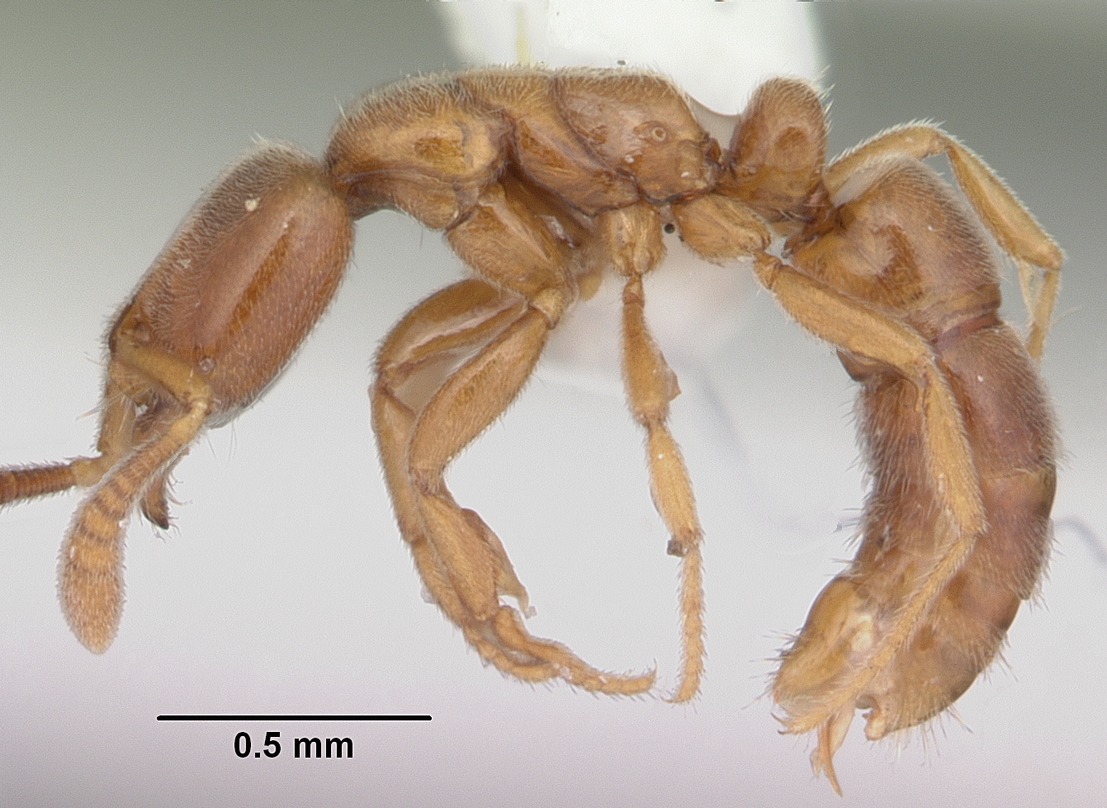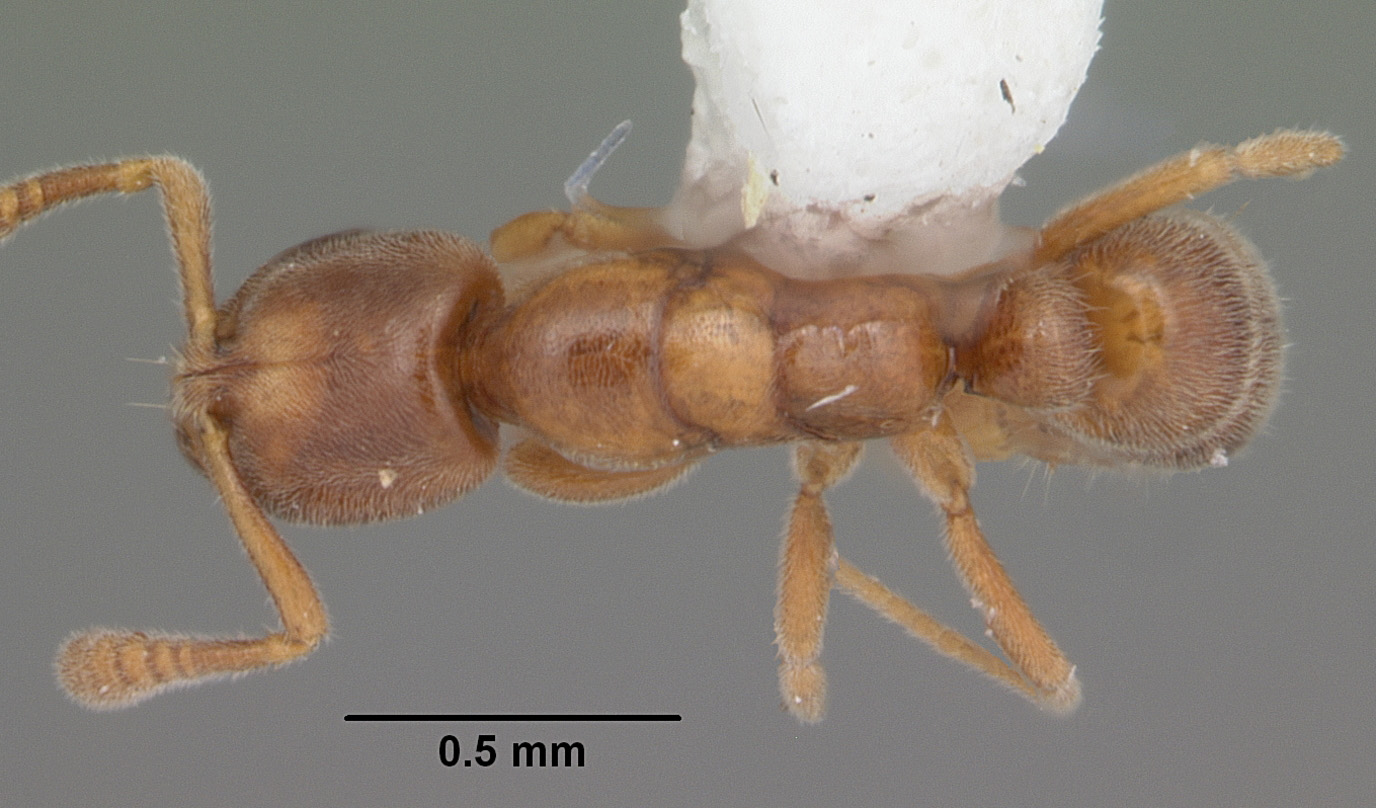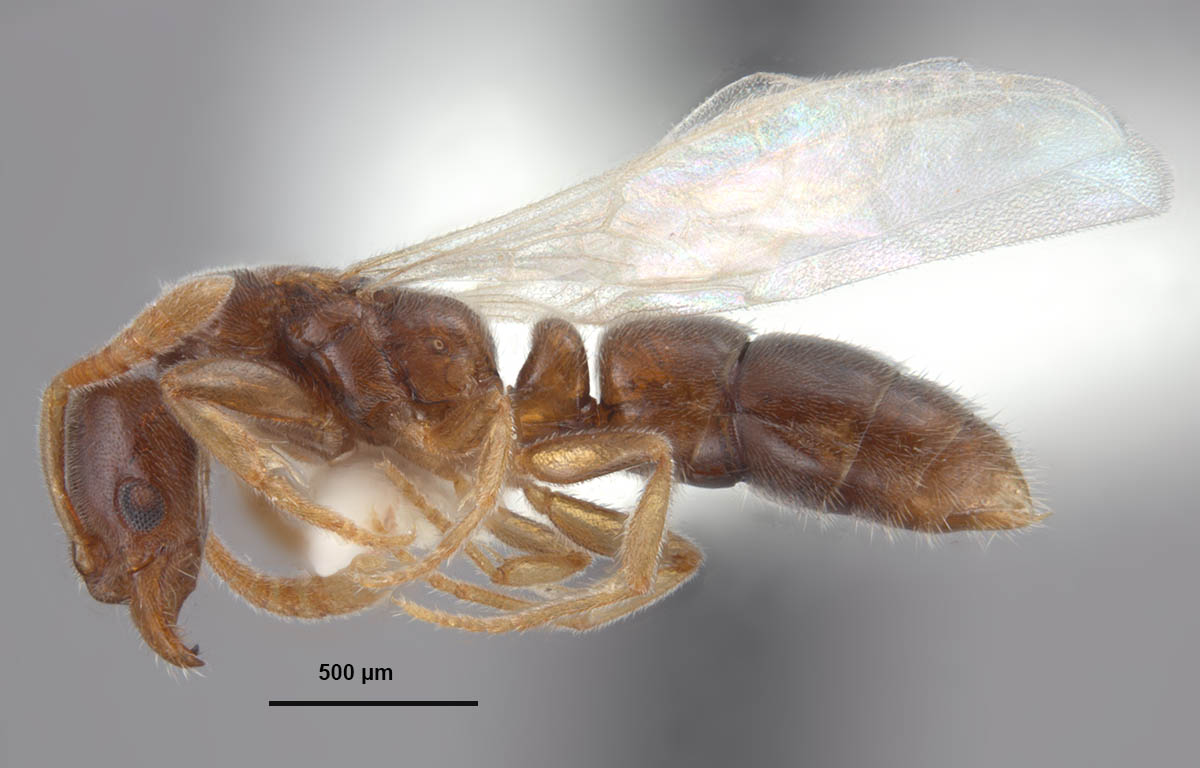Subfamily PONERINAE |
||
Hypoponera punctatissima, full face view of a worker (FL, Jefferson Co.) |
Hypoponera punctatissima, lateral view of a worker (FL, Jefferson Co.) Photo courtesy of http://www.antweb.org/ |
Hypoponera punctatissima, dorsal view of a worker (FL, Jefferson Co.) Photo courtesy of http://www.antweb.org/ |
Hypoponera punctatissima, full face view of a queen (MS, Jackson Co.) (photo by Ryan J. Whitehouse and Joe A. MacGown) |
Hypoponera punctatissima, lateral view of a queen (MS, Jackson Co.) (photo by Ryan J. Whitehouse and Joe A. MacGown) |
Hypoponera punctatissima, dorsal view of a queen (MS, Jackson Co.) (photo by Ryan J. Whitehouse and Joe A. MacGown) |
Introduction Hypoponera species can be identified by having a waist with only one distinct segment; gaster being narrowly connected to the waist; presence of a sting; apex of gaster pointed downwards or posteriorly; frontal lobes covering antennal insertion point; head and body relatively smooth; mandibles triangular; only one pectinate spur on hind tarsi; and subpetiolar process simple and not toothed. Hypoponera punctatissima (Roger) (Ponerinae) is small, yellowish brown stinging species thought to be native to Asia. Hypoponera punctatissima is possibly one of the most widespread tramp ants in the world. However, in the US, this species does not appear to be widespread or common, except in Florida where it is an occasional nuisance pest. Taxonomic History (Bolton 2016) Diagnosis Workers of Hypoponera punctatissima can be recognized by their small elongate body, narrowed head, yellowish brown to brown coloration, shiny integument with dense, appressed pubescence, tiny eye, single rounded petiolar node with simple subpetiolar process, the first two gastral segments enlarged, and the presence of a prominent sting. In Mississippi, this species is easily distinguished from others in the same genus by its much smaller size and from the very similar Ponera exotica Smith by the simple subpetiolar process. Identification Queen: (MEM measurements) Minute, slightly larger than workers (HL: 0.62-0.66mm, HW: 0.51-0.53mm, SL: 0.37-0.42mm, EL: 0.13-0.15mm, MeSL: 0.84-0.92mm) (n=5,). Overall coloration orangish-brown to brown, antennae and legs yellowish brown. Head longer than wide; shiny integuent somewhat dulled by numerous piligerous pits; entire head with dense appressed, short setae, setae denser along lateral edges; eyes large, located laterally on the anterior 1/3 of the head; ocelli present; mandibles triangular in shape; antennae 12-segmented with a three segmented club, scape does not reach posterior margin of the head. Mesosomal dorsum mostly flat in lateral view, enlarged for wings; promesonotal and metanotal sutures present; dorsum with dense short, hair-like setae; pronotum, mesopleuron, and propodeal sides with less dense setae, more shiny in appearance than dorsum. Waist single segmented, petiolar node subrectangular, about as wide as tall broadly rounded apically, with numerous short, erect setae present anteriorly, dorsally, and posteriorly and glabrous and shiny laterally; subpetiolar process simple, rounded. Gaster wity a definite constriction between segments one and two; first two segments twice the length or longer than the remaining segments; numerous setae present including a mixture of short hair-like setae and longer erect setae; prominent sting present. Male: (from Bolton and Fisher 2011) Ergatoid males are produced and fall into two categories with one group being larger, brown and with small eyes present and the second group being smaller, yellow and eyeless (Yamauchi, et al. 1996). These ergatoid males are very worker-like, especially in head structure, but have shorter scapes (SI 68–72), only 12-segmented antennae (as do workers, intercastes and queens), and fully developed male genitalia. Alate males have never been observed, and it is assumed that they do not exist. Biology and Economic Importance This cosmopolitan species is not considered to be economically important, but is considered to be an occasional stinging pest. Stings are usually from winged queens that become trapped beneath clothing or in sweat. Pest Status Distribution Australian: Australia, Federated States of Micronesia, Fiji, Guam, Hawaii, Marshall Islands, New Caledonia, New guinea, New Zealand, Niue, Norfolk Island, Northern Mariana Island, Palau, Samoa, Solomon Islands, Tonga, Wallis and Fortuna Islands (AntWiki.org). U.S. Distribution: AL, AZ, CA, FL, HI, IA, LA, MS, NC, NM, SC, TX, WA (AntWeb.org and MEM). Acknowledgments Literature Cited Atanassov, N.; Dlussky, G. M. 1992. Fauna of Bulgaria. Hymenoptera, Formicidae. [In Bulgarian.]. Fauna na Bûlgariya 22:1-310. Bolton, B. 2016. Bolton World Catalog Ants. Available online: http://www.antweb.org/world.jsp. Accessed 9 March 2016. Bolton, B.; Fisher, B. L. 2011. Taxonomy of Afrotropical and West Palaearctic ants of the ponerine genus Hypoponera Santschi (Hymenoptera: Formicidae). Zootaxa 2843:1-118. Collingwood, C. A. 1979. The Formicidae (Hymenoptera) of Fennoscandia and Denmark. Fauna Entomologica Scandinavica 8:1-174. Dalla Torre, K. W. 1893. Catalogus Hymenopterorum hucusque descriptorum systematicus et synonymicus. Vol. 7. Formicidae (Heterogyna). Leipzig: W. Engelmann, 289 pp. Delabie, J.H.C. & Blard, F. (2002) The tramp ant Hypoponera punctatissima (Roger) (Hymenoptera: Formicidae: Ponerinae): new records from the Southern Hemisphere. Neotrop. Entomol., 31, 149-151. Emery, C.; Forel, A. 1879. Catalogue des Formicides d'Europe. Mitteilungen der Schweizerischen Entomologischen Gesellschaft 5:441-481. Emery, C. 1916 ("1915"). Fauna entomologica italiana. I. Hymenoptera.-Formicidae. Bullettino della Società Entomologica Italiana 47:79-275. Roger, J. 1859. Beiträge zur Kenntniss der Ameisenfauna der Mittelmeerländer. I. Berliner Entomologische Zeitschrift 3:225-259. Seifert, B. 2003. Hypoponera punctatissima (Roger) and H. schauinslandi (Emery) - two morphologically and biologically distinct species (Hymenoptera: Formicidae). Abhandlungen und Berichte des Naturkundemuseums Görlitz 75(1):61-81. Seifert, B. 2013. Hypoponera ergatandria (Forel, 1893) - a cosmopolitan tramp species different from H. punctatissima (Roger, 1859) (Hymenoptera: Formicidae). Soil Organisms 85:189-201. Smith, D. R. 1979. Superfamily Formicoidea. Pp. 1323-1467 in: Krombein, K. V.; Hurd, P. D.; Smith, D. R.; Burks, B. D. (eds.) 1979. Catalog of Hymenoptera in America north of Mexico. Volume 2. Apocrita (Aculeata). Washington, D.C.: Smithsonian Institution Press, pp. i-xvi, 1199-2209. Taylor, R. W. 1967. A monographic revision of the ant genus Ponera Latreille (Hymenoptera: Formicidae). Pacific Insects Monograph 13:1-112. Taylor, R. W. 1987. A checklist of the ants of Australia, New Caledonia and New Zealand (Hymenoptera: Formicidae). CSIRO (Commonwealth Scientific and Industrial Research Organization) Division of Entomology Report 41:1-92. Wheeler, W. M. 1937. Mosaics and other anomalies among ants. Cambridge, Mass.: Harvard University Press, 95 pp. Wilson, E. O.; Taylor, R. W. 1967. The ants of Polynesia (Hymenoptera: Formicidae). Pacific Insects Monograph 14:1-109. Yamauchi, K., Kimura, Y., Corbara, B., Kinomura, K. & Tsuji, K. 1996. Dimorphic ergatoid males and their reproductive behavior in the ponerine ant Hypoponera bondroiti. Insectes Sociaux 43: 119-130 |
||








